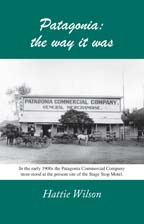
Patagonia: the way it was
by Hattie Wilson
5.5 x 8.5, 138 pages, soft cover
Price $10.00
From the Preface
These memories are presented as far as possible in the words and cadences of the people interviewed. You’ll notice most of the interviews were made in the 1970s. That’s when I came out to Arizona from Chicago and was taken with the ranch women I met at Cowbelles. Later I branched out and recorded some men: Blain Lewis, Stone Collie, Judge Gordon Farley.
Catherine Henn, who was secretary of the Pimeria Alta Historical Society then, got me started. She introduced me to people and helped me ask the right questions.
In the ’70s there was interest in recording memories at the Arizona Historical Society and Tom Peterson there helped out by paying for my gas. Then I moved on to other things. Thirty years passed and as far as I know no one took any of those tapes out. No historical papers were written based on them.
And they were so interesting. Inez Jones’ account of her laundry days should be read. Fay Parker told a good story too. Deputy Blain Lewis’ fatherly care of drunken miners was small town law enforcement, different from the city police I knew, and the story of Lon Parker’s death is a Western epic. These were hidden away on reels of tape and likely to stay that way until they became brittle and disintegrated.
They had to be replayed and written up and they had to be made to hang together to tell a story. I made a common theme of the town of Patagonia. Some connection could be made for all of these people at Patagonia, although you’ll notice some had to be worked on.
The town made a center. The title “Patagonia: the way it was” appealed to me and a book about Patagonia has a market at Ann Caton’s Mariposa Books.
Reading these interviews over I feel I could have done better with some of them, but these people have had their say, at least, and besides that, you’ll find yourself growing fond of them as I did.
The book is available directly from the author at 624 Nopal Ct., Rio Rico, AZ 85648